Economics for Business: Demand and Supply Analysis of Australian Beef
VerifiedAdded on 2023/06/12
|10
|1694
|185
Report
AI Summary
This report provides an economic analysis of the Australian beef industry, focusing on the dynamics of demand and supply. Utilizing news articles and economic concepts, it examines the factors contributing to recent price decreases in beef cattle, including increased supply due to favorable weather conditions and decreased global demand. The report also discusses the potential impact of early wet seasons, competition from Asian markets, and changes in demand from China and the USA. The concept of economies of scale is explored, highlighting how increased production can lower costs for beef producers. Finally, the report offers recommendations for government intervention, such as implementing new trade policies and providing subsidies to beef producers, to mitigate price falls and support the industry's economic stability. Desklib provides access to similar reports and study resources.
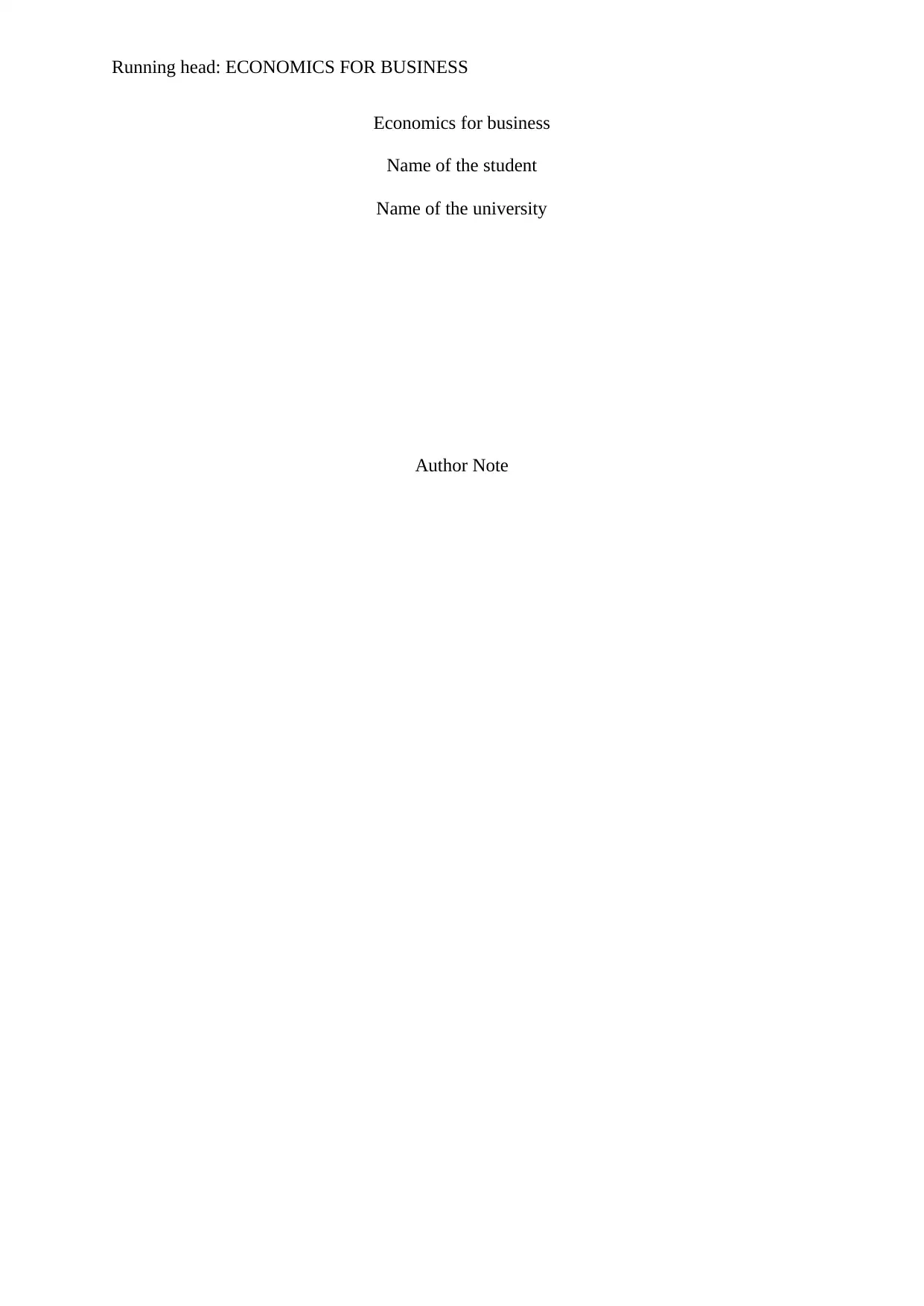
Running head: ECONOMICS FOR BUSINESS
Economics for business
Name of the student
Name of the university
Author Note
Economics for business
Name of the student
Name of the university
Author Note
Paraphrase This Document
Need a fresh take? Get an instant paraphrase of this document with our AI Paraphraser
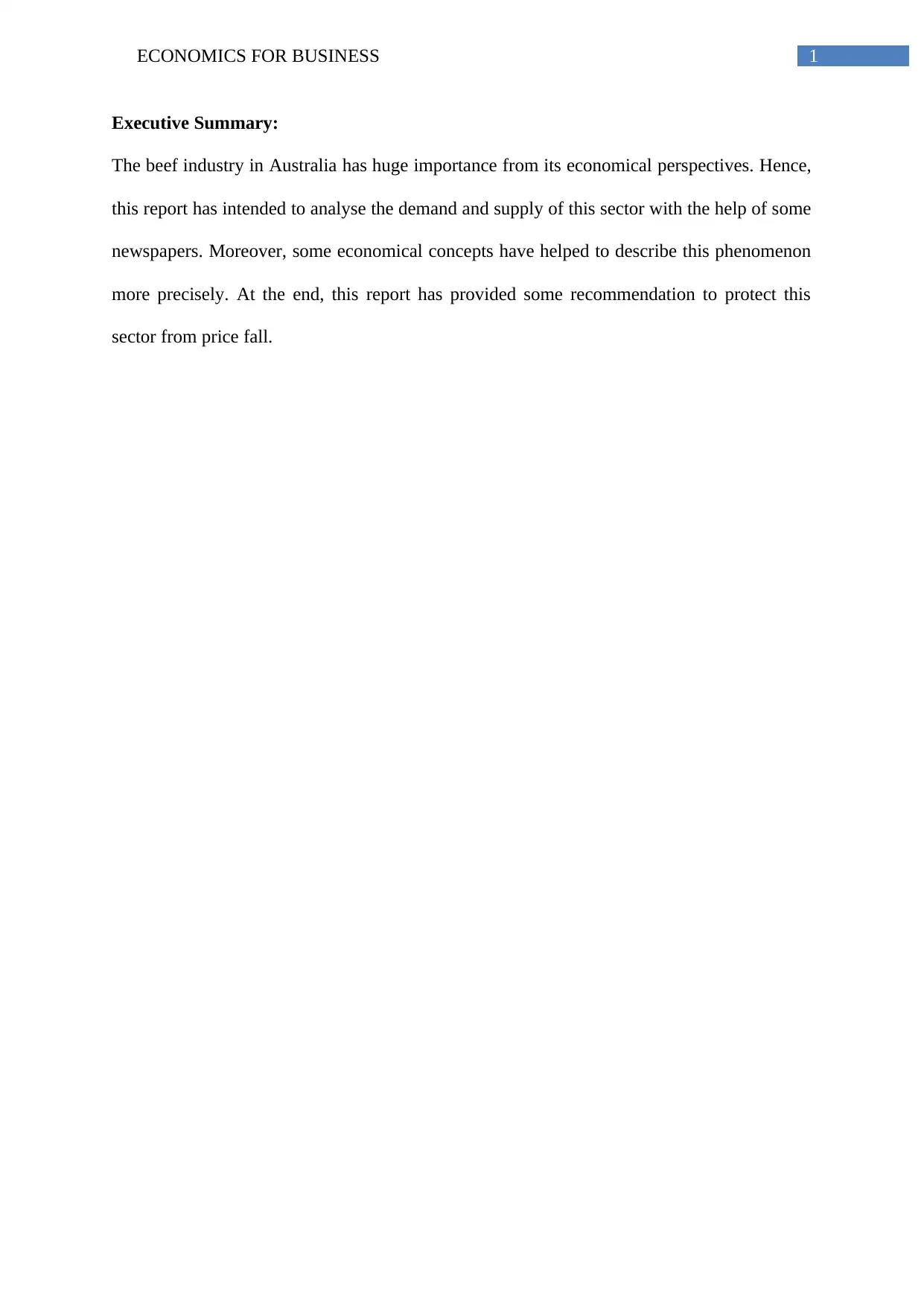
1ECONOMICS FOR BUSINESS
Executive Summary:
The beef industry in Australia has huge importance from its economical perspectives. Hence,
this report has intended to analyse the demand and supply of this sector with the help of some
newspapers. Moreover, some economical concepts have helped to describe this phenomenon
more precisely. At the end, this report has provided some recommendation to protect this
sector from price fall.
Executive Summary:
The beef industry in Australia has huge importance from its economical perspectives. Hence,
this report has intended to analyse the demand and supply of this sector with the help of some
newspapers. Moreover, some economical concepts have helped to describe this phenomenon
more precisely. At the end, this report has provided some recommendation to protect this
sector from price fall.
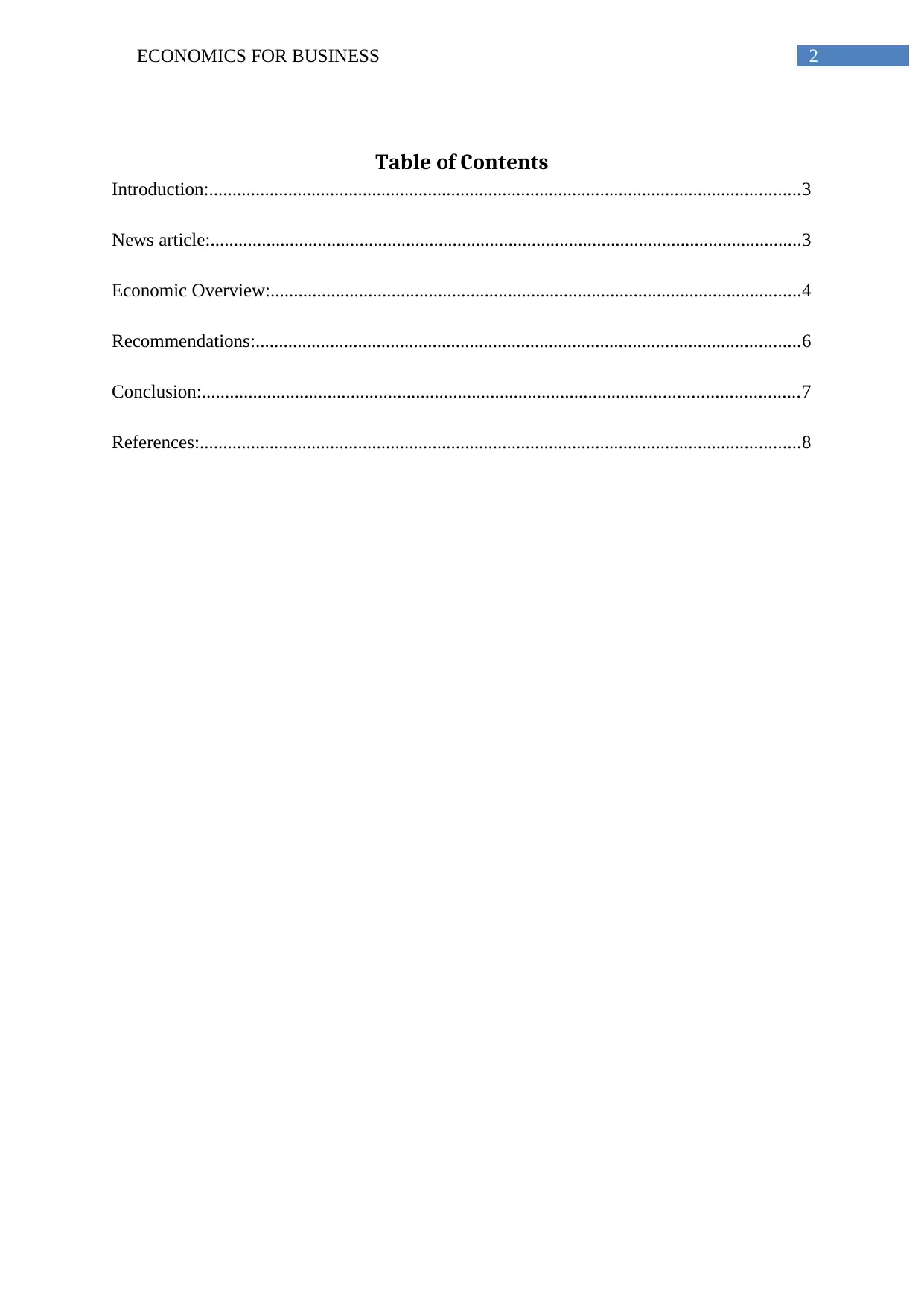
2ECONOMICS FOR BUSINESS
Table of Contents
Introduction:...............................................................................................................................3
News article:...............................................................................................................................3
Economic Overview:..................................................................................................................4
Recommendations:.....................................................................................................................6
Conclusion:................................................................................................................................7
References:.................................................................................................................................8
Table of Contents
Introduction:...............................................................................................................................3
News article:...............................................................................................................................3
Economic Overview:..................................................................................................................4
Recommendations:.....................................................................................................................6
Conclusion:................................................................................................................................7
References:.................................................................................................................................8
⊘ This is a preview!⊘
Do you want full access?
Subscribe today to unlock all pages.

Trusted by 1+ million students worldwide
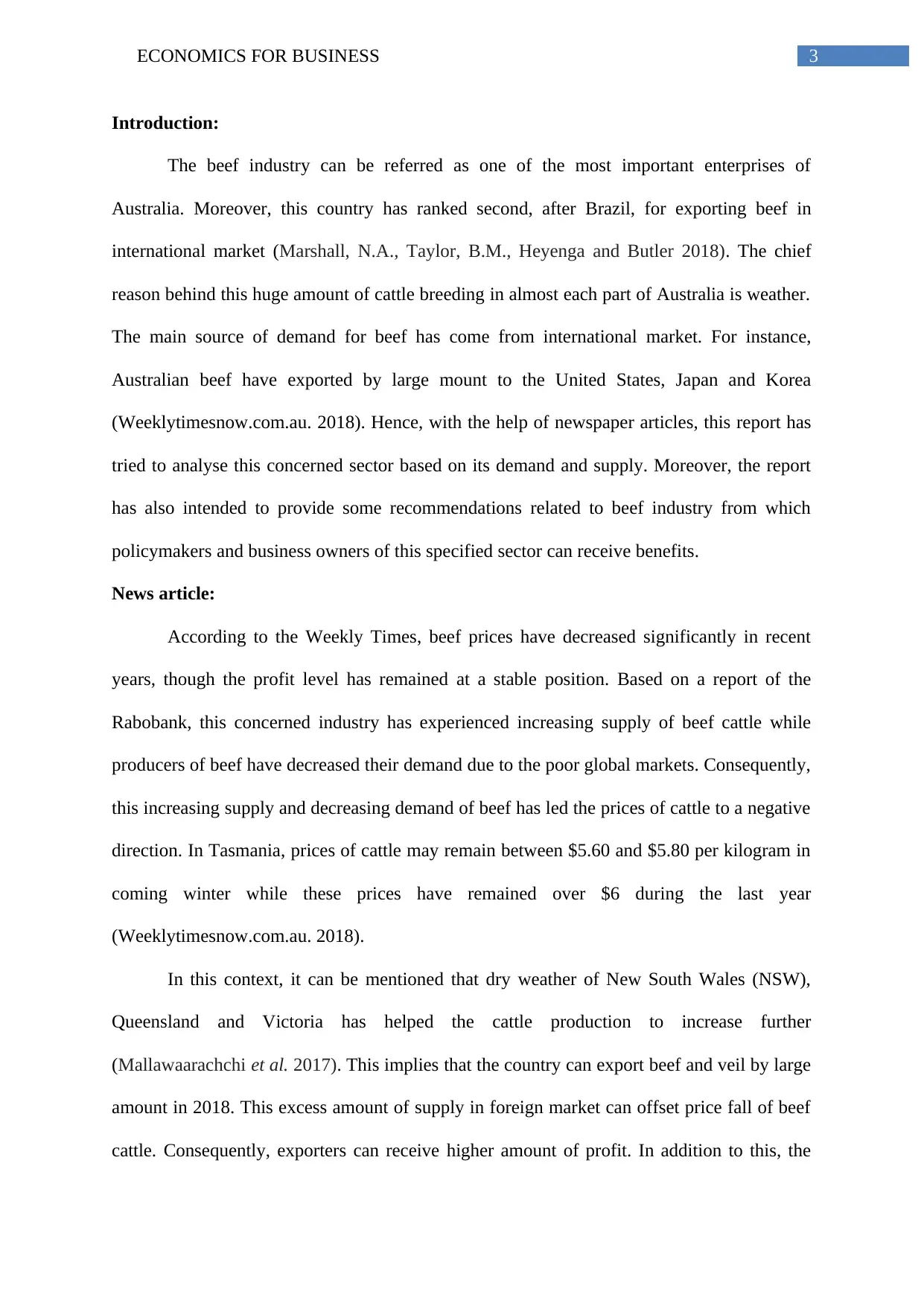
3ECONOMICS FOR BUSINESS
Introduction:
The beef industry can be referred as one of the most important enterprises of
Australia. Moreover, this country has ranked second, after Brazil, for exporting beef in
international market (Marshall, N.A., Taylor, B.M., Heyenga and Butler 2018). The chief
reason behind this huge amount of cattle breeding in almost each part of Australia is weather.
The main source of demand for beef has come from international market. For instance,
Australian beef have exported by large mount to the United States, Japan and Korea
(Weeklytimesnow.com.au. 2018). Hence, with the help of newspaper articles, this report has
tried to analyse this concerned sector based on its demand and supply. Moreover, the report
has also intended to provide some recommendations related to beef industry from which
policymakers and business owners of this specified sector can receive benefits.
News article:
According to the Weekly Times, beef prices have decreased significantly in recent
years, though the profit level has remained at a stable position. Based on a report of the
Rabobank, this concerned industry has experienced increasing supply of beef cattle while
producers of beef have decreased their demand due to the poor global markets. Consequently,
this increasing supply and decreasing demand of beef has led the prices of cattle to a negative
direction. In Tasmania, prices of cattle may remain between $5.60 and $5.80 per kilogram in
coming winter while these prices have remained over $6 during the last year
(Weeklytimesnow.com.au. 2018).
In this context, it can be mentioned that dry weather of New South Wales (NSW),
Queensland and Victoria has helped the cattle production to increase further
(Mallawaarachchi et al. 2017). This implies that the country can export beef and veil by large
amount in 2018. This excess amount of supply in foreign market can offset price fall of beef
cattle. Consequently, exporters can receive higher amount of profit. In addition to this, the
Introduction:
The beef industry can be referred as one of the most important enterprises of
Australia. Moreover, this country has ranked second, after Brazil, for exporting beef in
international market (Marshall, N.A., Taylor, B.M., Heyenga and Butler 2018). The chief
reason behind this huge amount of cattle breeding in almost each part of Australia is weather.
The main source of demand for beef has come from international market. For instance,
Australian beef have exported by large mount to the United States, Japan and Korea
(Weeklytimesnow.com.au. 2018). Hence, with the help of newspaper articles, this report has
tried to analyse this concerned sector based on its demand and supply. Moreover, the report
has also intended to provide some recommendations related to beef industry from which
policymakers and business owners of this specified sector can receive benefits.
News article:
According to the Weekly Times, beef prices have decreased significantly in recent
years, though the profit level has remained at a stable position. Based on a report of the
Rabobank, this concerned industry has experienced increasing supply of beef cattle while
producers of beef have decreased their demand due to the poor global markets. Consequently,
this increasing supply and decreasing demand of beef has led the prices of cattle to a negative
direction. In Tasmania, prices of cattle may remain between $5.60 and $5.80 per kilogram in
coming winter while these prices have remained over $6 during the last year
(Weeklytimesnow.com.au. 2018).
In this context, it can be mentioned that dry weather of New South Wales (NSW),
Queensland and Victoria has helped the cattle production to increase further
(Mallawaarachchi et al. 2017). This implies that the country can export beef and veil by large
amount in 2018. This excess amount of supply in foreign market can offset price fall of beef
cattle. Consequently, exporters can receive higher amount of profit. In addition to this, the
Paraphrase This Document
Need a fresh take? Get an instant paraphrase of this document with our AI Paraphraser
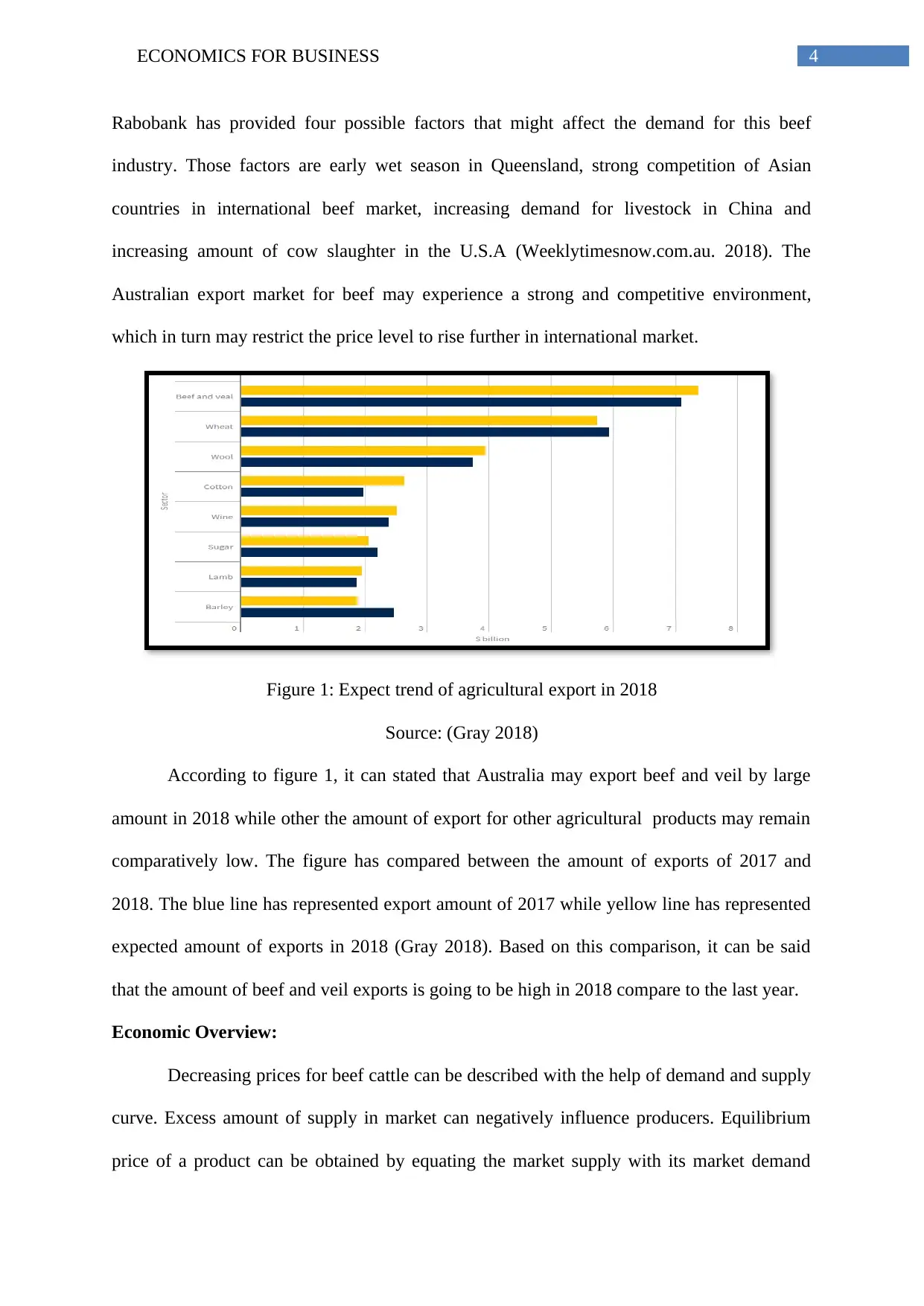
4ECONOMICS FOR BUSINESS
Rabobank has provided four possible factors that might affect the demand for this beef
industry. Those factors are early wet season in Queensland, strong competition of Asian
countries in international beef market, increasing demand for livestock in China and
increasing amount of cow slaughter in the U.S.A (Weeklytimesnow.com.au. 2018). The
Australian export market for beef may experience a strong and competitive environment,
which in turn may restrict the price level to rise further in international market.
Figure 1: Expect trend of agricultural export in 2018
Source: (Gray 2018)
According to figure 1, it can stated that Australia may export beef and veil by large
amount in 2018 while other the amount of export for other agricultural products may remain
comparatively low. The figure has compared between the amount of exports of 2017 and
2018. The blue line has represented export amount of 2017 while yellow line has represented
expected amount of exports in 2018 (Gray 2018). Based on this comparison, it can be said
that the amount of beef and veil exports is going to be high in 2018 compare to the last year.
Economic Overview:
Decreasing prices for beef cattle can be described with the help of demand and supply
curve. Excess amount of supply in market can negatively influence producers. Equilibrium
price of a product can be obtained by equating the market supply with its market demand
Rabobank has provided four possible factors that might affect the demand for this beef
industry. Those factors are early wet season in Queensland, strong competition of Asian
countries in international beef market, increasing demand for livestock in China and
increasing amount of cow slaughter in the U.S.A (Weeklytimesnow.com.au. 2018). The
Australian export market for beef may experience a strong and competitive environment,
which in turn may restrict the price level to rise further in international market.
Figure 1: Expect trend of agricultural export in 2018
Source: (Gray 2018)
According to figure 1, it can stated that Australia may export beef and veil by large
amount in 2018 while other the amount of export for other agricultural products may remain
comparatively low. The figure has compared between the amount of exports of 2017 and
2018. The blue line has represented export amount of 2017 while yellow line has represented
expected amount of exports in 2018 (Gray 2018). Based on this comparison, it can be said
that the amount of beef and veil exports is going to be high in 2018 compare to the last year.
Economic Overview:
Decreasing prices for beef cattle can be described with the help of demand and supply
curve. Excess amount of supply in market can negatively influence producers. Equilibrium
price of a product can be obtained by equating the market supply with its market demand
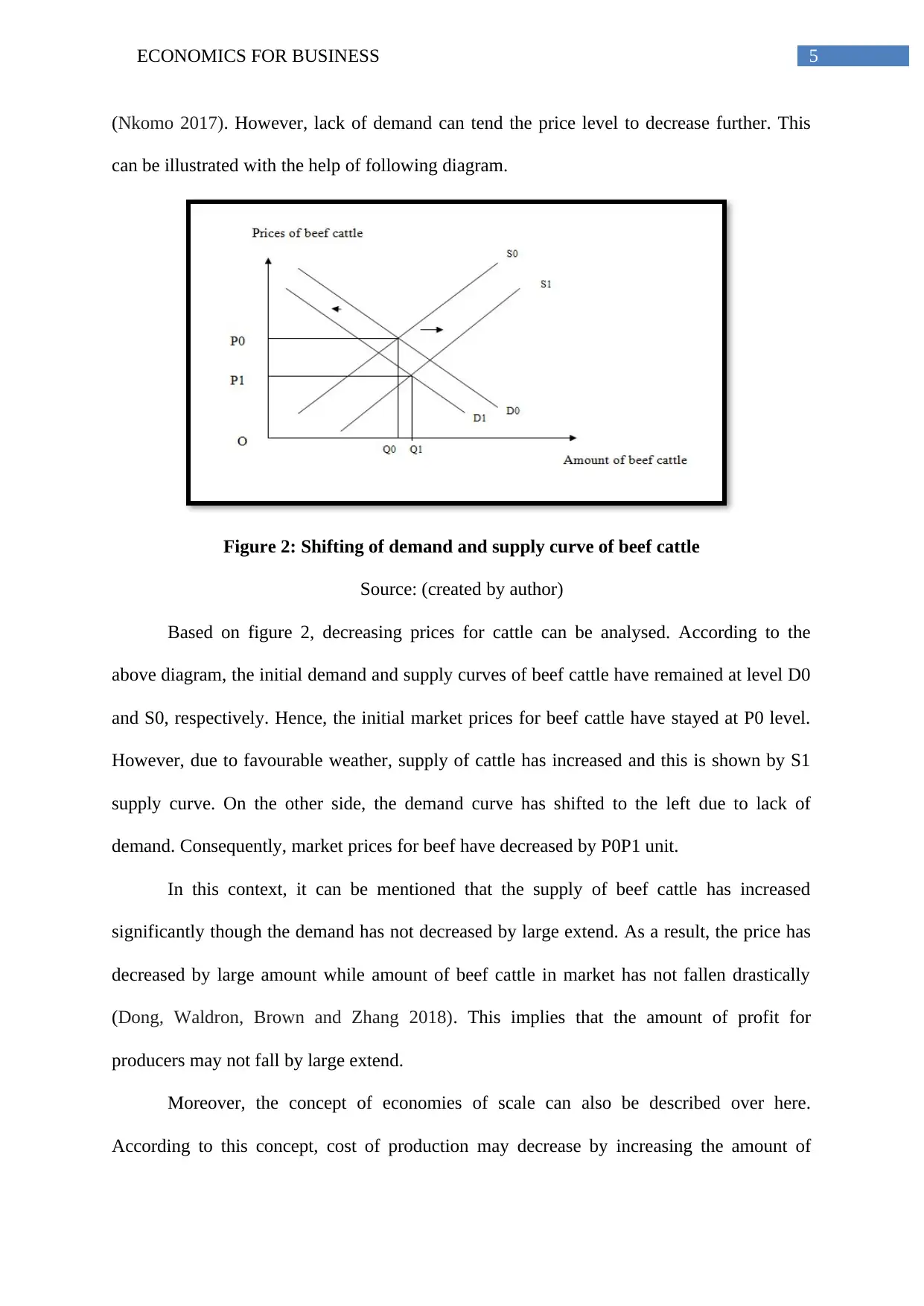
5ECONOMICS FOR BUSINESS
(Nkomo 2017). However, lack of demand can tend the price level to decrease further. This
can be illustrated with the help of following diagram.
Figure 2: Shifting of demand and supply curve of beef cattle
Source: (created by author)
Based on figure 2, decreasing prices for cattle can be analysed. According to the
above diagram, the initial demand and supply curves of beef cattle have remained at level D0
and S0, respectively. Hence, the initial market prices for beef cattle have stayed at P0 level.
However, due to favourable weather, supply of cattle has increased and this is shown by S1
supply curve. On the other side, the demand curve has shifted to the left due to lack of
demand. Consequently, market prices for beef have decreased by P0P1 unit.
In this context, it can be mentioned that the supply of beef cattle has increased
significantly though the demand has not decreased by large extend. As a result, the price has
decreased by large amount while amount of beef cattle in market has not fallen drastically
(Dong, Waldron, Brown and Zhang 2018). This implies that the amount of profit for
producers may not fall by large extend.
Moreover, the concept of economies of scale can also be described over here.
According to this concept, cost of production may decrease by increasing the amount of
(Nkomo 2017). However, lack of demand can tend the price level to decrease further. This
can be illustrated with the help of following diagram.
Figure 2: Shifting of demand and supply curve of beef cattle
Source: (created by author)
Based on figure 2, decreasing prices for cattle can be analysed. According to the
above diagram, the initial demand and supply curves of beef cattle have remained at level D0
and S0, respectively. Hence, the initial market prices for beef cattle have stayed at P0 level.
However, due to favourable weather, supply of cattle has increased and this is shown by S1
supply curve. On the other side, the demand curve has shifted to the left due to lack of
demand. Consequently, market prices for beef have decreased by P0P1 unit.
In this context, it can be mentioned that the supply of beef cattle has increased
significantly though the demand has not decreased by large extend. As a result, the price has
decreased by large amount while amount of beef cattle in market has not fallen drastically
(Dong, Waldron, Brown and Zhang 2018). This implies that the amount of profit for
producers may not fall by large extend.
Moreover, the concept of economies of scale can also be described over here.
According to this concept, cost of production may decrease by increasing the amount of
⊘ This is a preview!⊘
Do you want full access?
Subscribe today to unlock all pages.

Trusted by 1+ million students worldwide
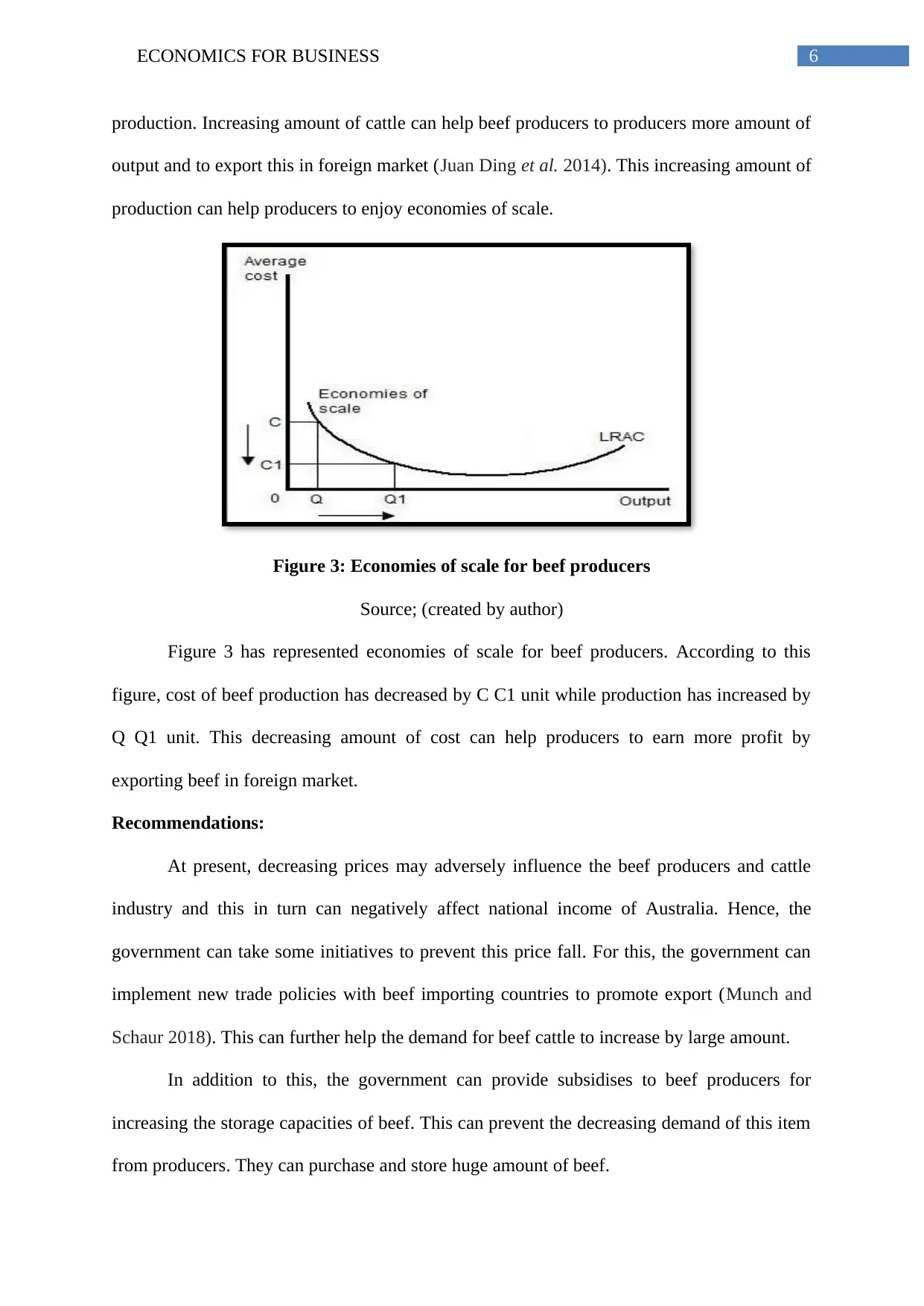
6ECONOMICS FOR BUSINESS
production. Increasing amount of cattle can help beef producers to producers more amount of
output and to export this in foreign market (Juan Ding et al. 2014). This increasing amount of
production can help producers to enjoy economies of scale.
Figure 3: Economies of scale for beef producers
Source; (created by author)
Figure 3 has represented economies of scale for beef producers. According to this
figure, cost of beef production has decreased by C C1 unit while production has increased by
Q Q1 unit. This decreasing amount of cost can help producers to earn more profit by
exporting beef in foreign market.
Recommendations:
At present, decreasing prices may adversely influence the beef producers and cattle
industry and this in turn can negatively affect national income of Australia. Hence, the
government can take some initiatives to prevent this price fall. For this, the government can
implement new trade policies with beef importing countries to promote export (Munch and
Schaur 2018). This can further help the demand for beef cattle to increase by large amount.
In addition to this, the government can provide subsidises to beef producers for
increasing the storage capacities of beef. This can prevent the decreasing demand of this item
from producers. They can purchase and store huge amount of beef.
production. Increasing amount of cattle can help beef producers to producers more amount of
output and to export this in foreign market (Juan Ding et al. 2014). This increasing amount of
production can help producers to enjoy economies of scale.
Figure 3: Economies of scale for beef producers
Source; (created by author)
Figure 3 has represented economies of scale for beef producers. According to this
figure, cost of beef production has decreased by C C1 unit while production has increased by
Q Q1 unit. This decreasing amount of cost can help producers to earn more profit by
exporting beef in foreign market.
Recommendations:
At present, decreasing prices may adversely influence the beef producers and cattle
industry and this in turn can negatively affect national income of Australia. Hence, the
government can take some initiatives to prevent this price fall. For this, the government can
implement new trade policies with beef importing countries to promote export (Munch and
Schaur 2018). This can further help the demand for beef cattle to increase by large amount.
In addition to this, the government can provide subsidises to beef producers for
increasing the storage capacities of beef. This can prevent the decreasing demand of this item
from producers. They can purchase and store huge amount of beef.
Paraphrase This Document
Need a fresh take? Get an instant paraphrase of this document with our AI Paraphraser
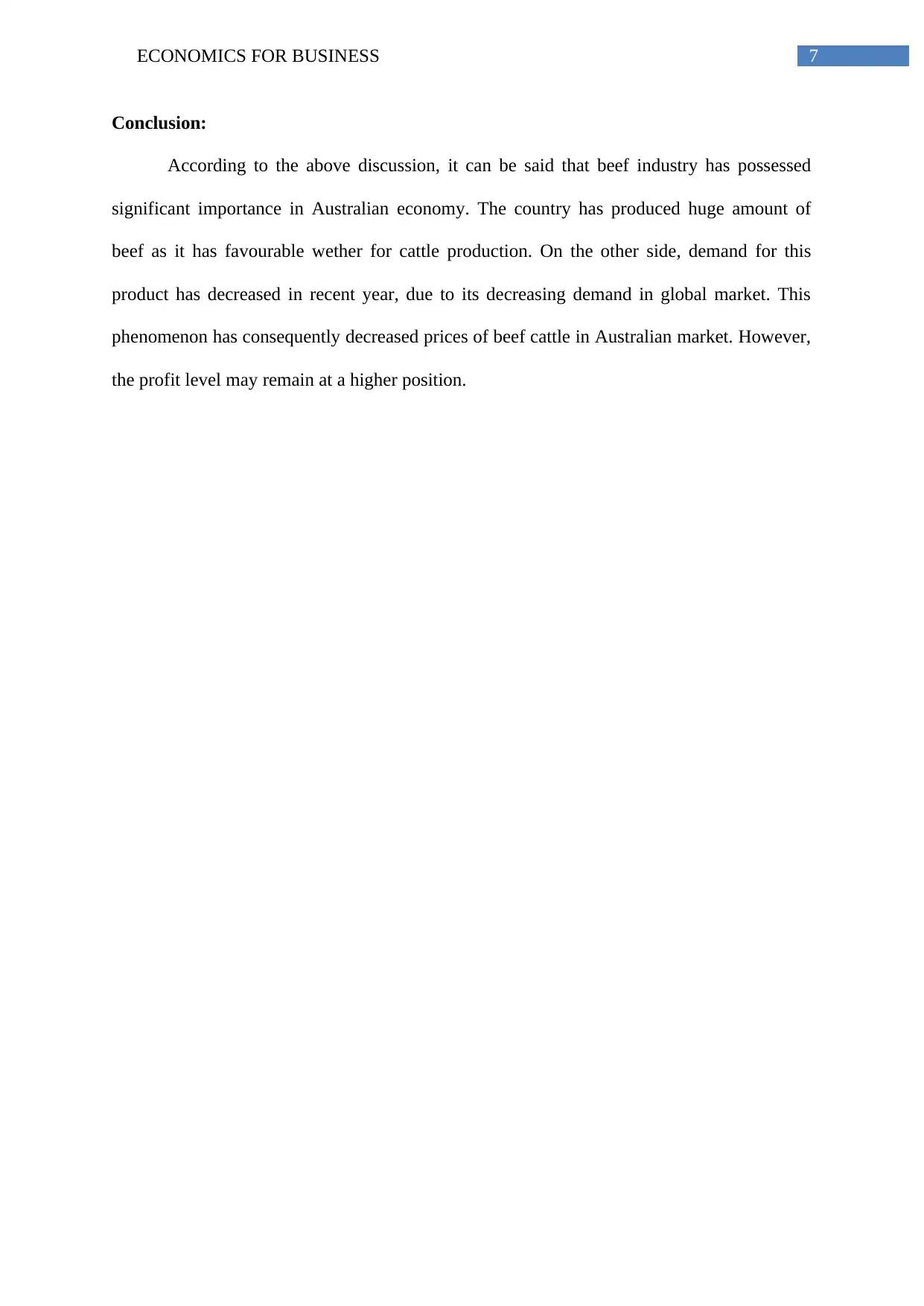
7ECONOMICS FOR BUSINESS
Conclusion:
According to the above discussion, it can be said that beef industry has possessed
significant importance in Australian economy. The country has produced huge amount of
beef as it has favourable wether for cattle production. On the other side, demand for this
product has decreased in recent year, due to its decreasing demand in global market. This
phenomenon has consequently decreased prices of beef cattle in Australian market. However,
the profit level may remain at a higher position.
Conclusion:
According to the above discussion, it can be said that beef industry has possessed
significant importance in Australian economy. The country has produced huge amount of
beef as it has favourable wether for cattle production. On the other side, demand for this
product has decreased in recent year, due to its decreasing demand in global market. This
phenomenon has consequently decreased prices of beef cattle in Australian market. However,
the profit level may remain at a higher position.
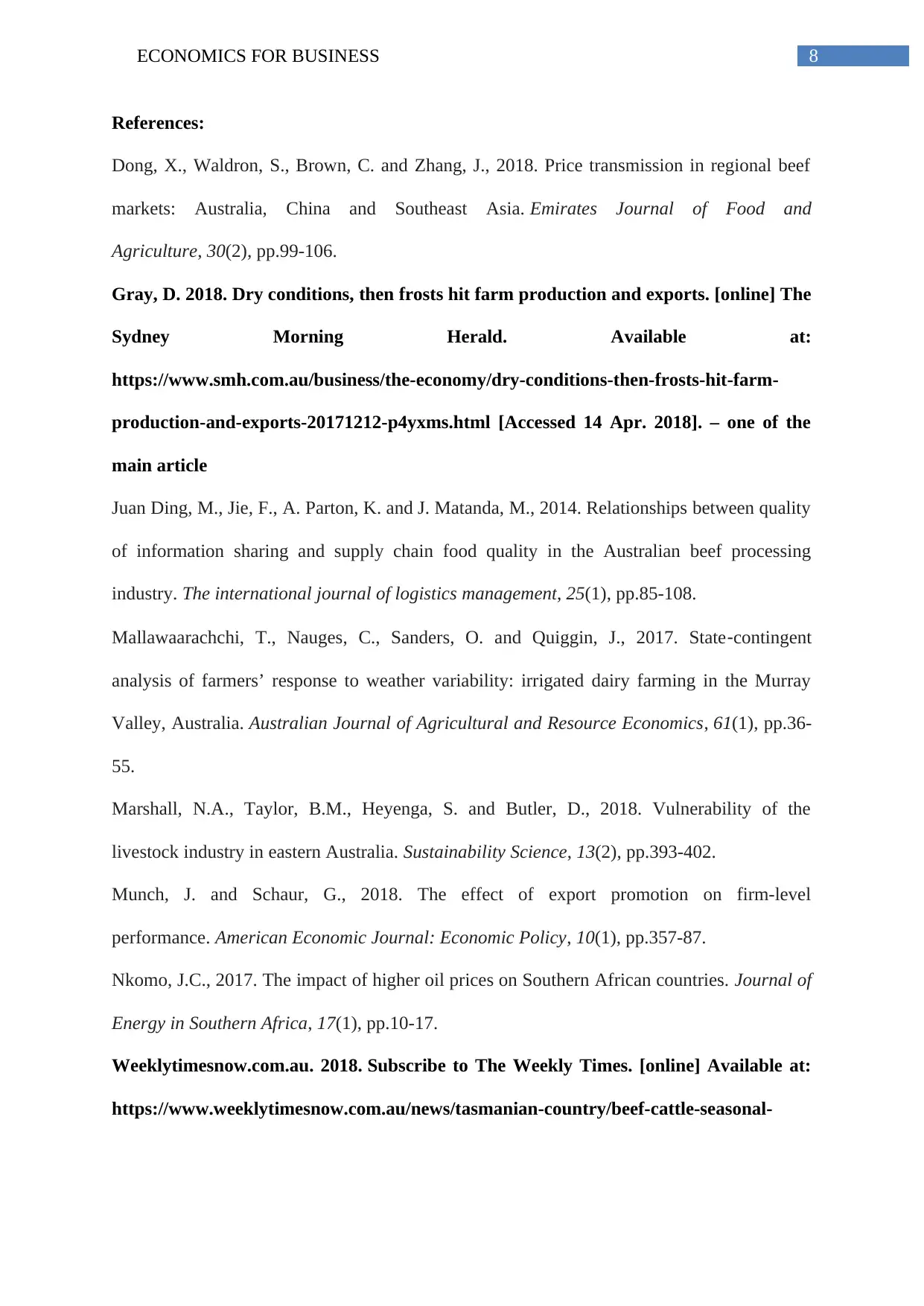
8ECONOMICS FOR BUSINESS
References:
Dong, X., Waldron, S., Brown, C. and Zhang, J., 2018. Price transmission in regional beef
markets: Australia, China and Southeast Asia. Emirates Journal of Food and
Agriculture, 30(2), pp.99-106.
Gray, D. 2018. Dry conditions, then frosts hit farm production and exports. [online] The
Sydney Morning Herald. Available at:
https://www.smh.com.au/business/the-economy/dry-conditions-then-frosts-hit-farm-
production-and-exports-20171212-p4yxms.html [Accessed 14 Apr. 2018]. – one of the
main article
Juan Ding, M., Jie, F., A. Parton, K. and J. Matanda, M., 2014. Relationships between quality
of information sharing and supply chain food quality in the Australian beef processing
industry. The international journal of logistics management, 25(1), pp.85-108.
Mallawaarachchi, T., Nauges, C., Sanders, O. and Quiggin, J., 2017. State‐contingent
analysis of farmers’ response to weather variability: irrigated dairy farming in the Murray
Valley, Australia. Australian Journal of Agricultural and Resource Economics, 61(1), pp.36-
55.
Marshall, N.A., Taylor, B.M., Heyenga, S. and Butler, D., 2018. Vulnerability of the
livestock industry in eastern Australia. Sustainability Science, 13(2), pp.393-402.
Munch, J. and Schaur, G., 2018. The effect of export promotion on firm-level
performance. American Economic Journal: Economic Policy, 10(1), pp.357-87.
Nkomo, J.C., 2017. The impact of higher oil prices on Southern African countries. Journal of
Energy in Southern Africa, 17(1), pp.10-17.
Weeklytimesnow.com.au. 2018. Subscribe to The Weekly Times. [online] Available at:
https://www.weeklytimesnow.com.au/news/tasmanian-country/beef-cattle-seasonal-
References:
Dong, X., Waldron, S., Brown, C. and Zhang, J., 2018. Price transmission in regional beef
markets: Australia, China and Southeast Asia. Emirates Journal of Food and
Agriculture, 30(2), pp.99-106.
Gray, D. 2018. Dry conditions, then frosts hit farm production and exports. [online] The
Sydney Morning Herald. Available at:
https://www.smh.com.au/business/the-economy/dry-conditions-then-frosts-hit-farm-
production-and-exports-20171212-p4yxms.html [Accessed 14 Apr. 2018]. – one of the
main article
Juan Ding, M., Jie, F., A. Parton, K. and J. Matanda, M., 2014. Relationships between quality
of information sharing and supply chain food quality in the Australian beef processing
industry. The international journal of logistics management, 25(1), pp.85-108.
Mallawaarachchi, T., Nauges, C., Sanders, O. and Quiggin, J., 2017. State‐contingent
analysis of farmers’ response to weather variability: irrigated dairy farming in the Murray
Valley, Australia. Australian Journal of Agricultural and Resource Economics, 61(1), pp.36-
55.
Marshall, N.A., Taylor, B.M., Heyenga, S. and Butler, D., 2018. Vulnerability of the
livestock industry in eastern Australia. Sustainability Science, 13(2), pp.393-402.
Munch, J. and Schaur, G., 2018. The effect of export promotion on firm-level
performance. American Economic Journal: Economic Policy, 10(1), pp.357-87.
Nkomo, J.C., 2017. The impact of higher oil prices on Southern African countries. Journal of
Energy in Southern Africa, 17(1), pp.10-17.
Weeklytimesnow.com.au. 2018. Subscribe to The Weekly Times. [online] Available at:
https://www.weeklytimesnow.com.au/news/tasmanian-country/beef-cattle-seasonal-
⊘ This is a preview!⊘
Do you want full access?
Subscribe today to unlock all pages.

Trusted by 1+ million students worldwide
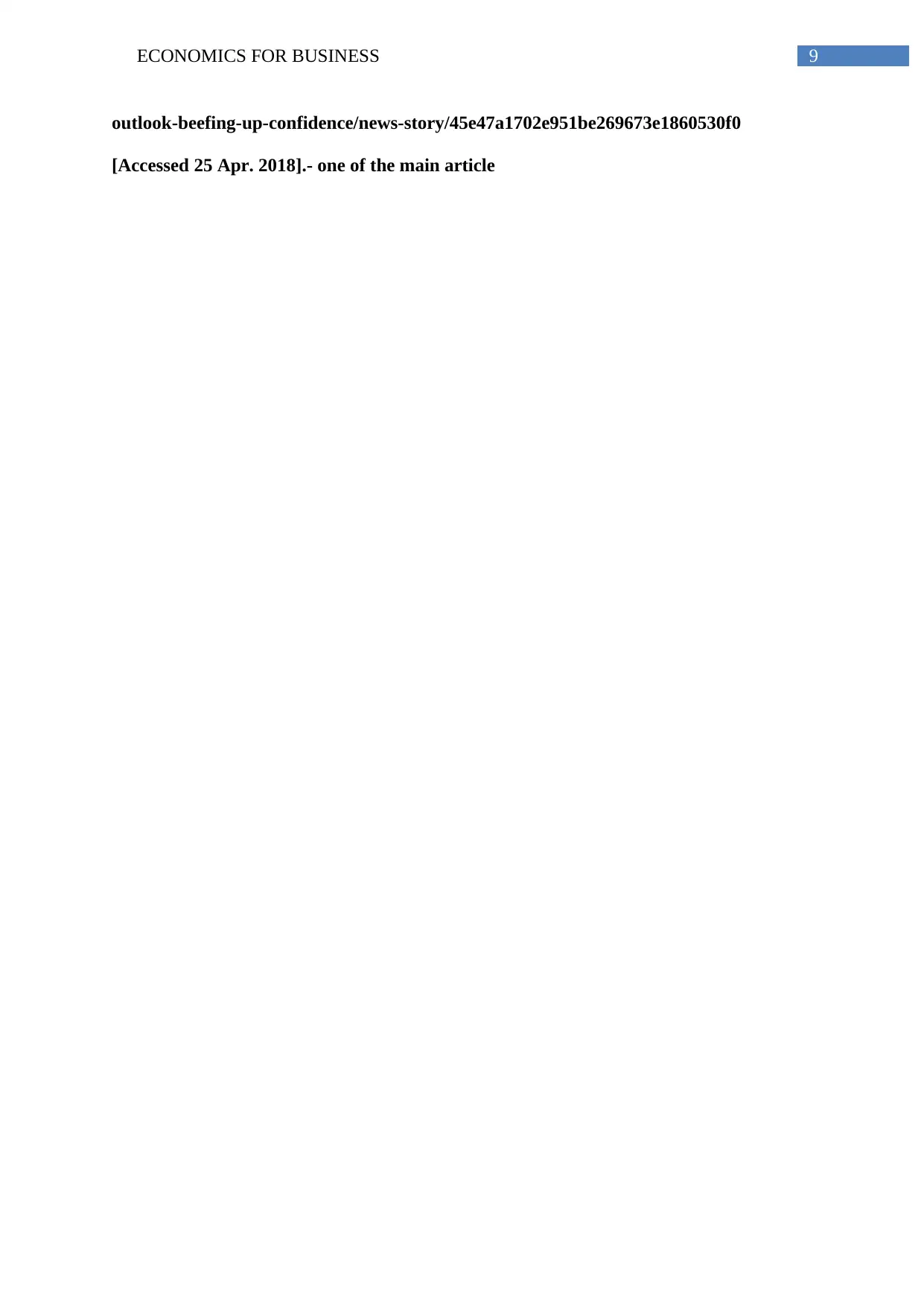
9ECONOMICS FOR BUSINESS
outlook-beefing-up-confidence/news-story/45e47a1702e951be269673e1860530f0
[Accessed 25 Apr. 2018].- one of the main article
outlook-beefing-up-confidence/news-story/45e47a1702e951be269673e1860530f0
[Accessed 25 Apr. 2018].- one of the main article
1 out of 10
Related Documents
Your All-in-One AI-Powered Toolkit for Academic Success.
+13062052269
info@desklib.com
Available 24*7 on WhatsApp / Email
![[object Object]](/_next/static/media/star-bottom.7253800d.svg)
Unlock your academic potential
Copyright © 2020–2025 A2Z Services. All Rights Reserved. Developed and managed by ZUCOL.





